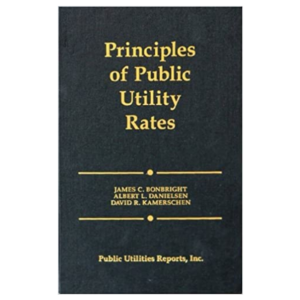
The Electric Transition and Obsolescence
By
Branko Terzic
The nation’s electric grid must be rebuilt, expanded and digitized. Partly this will be due to the introduction of the “smart grid”, “micro-grids” and “the Internet of everything.” In addition, the transition of transportation from internal combustion engines to electric vehicles has been estimated to require doubling the grid by 2050. If this is true, why aren’t regulators recognizing that the current grid will need replacement sooner than expected and reflect that in current depreciation rates? The operative issue is one of extraordinary obsolescence.
In Principles of Utility Rates Professor James Bonbright explained that:
“…extraordinary obsolescence should be considered when evaluating appropriate service lives.” He went on to explain that “In regulation, the allowances for depreciation both as operating expenses and as deductible reserves are designed to cover functional depreciation including obsolescence and not merely physical deterioration or wear and tear. Hence the allowances must be based on estimates or plausible assumptions as to the effect of obsolescence on useful-life expectancies. “
There is however a problem, as Bonbright asserts that, “…neither a corporate management nor a commission can hope accurately to predict, years in advance of the event, dates as of which old properties may need to be retired for reasons of “extraordinary obsolescence”.
But I believe they can in certain cases. The 1996 NARUC manual Public Utility Depreciation Practices describes the various factors which affect the economic service life of public utility assets including:
- Observable trends reflected in historical data;
- Potential changes in the type of property installed;
- Changes in the physical environment;
- Changes in management requirements;
- Changes in government requirements; and
- Obsolescence due to the introduction of new technologies
Clearly needing to expand the electric system due to government mandated “transition” to electric vehicles meets the criteria #5. The last reason #6 “Obsolescence due to the introduction of new technologies” is also an issue here with respect to the electric industry in the USA.
The question for regulators and management today is whether we are at the point where new technologies, in this case “digital” and “internet”, will provide services unavailable or in a superior fashion to the service provided by existing electro-mechanical equipment. If this is the case today then existing technology becomes “obsolete” even though it is still in service. The appropriate rate-making treatment is to recognize the shorter “remaining life” by increasing the depreciation rate or even, in extreme cases, by immediate write offs.
Thus, management and regulators find themselves with a requirement for two separate exercises in judgement. The first is the estimate of remaining life of the older technology, and the second is to make an estimate of the economic life of the new technology. In the second instance the question would be something like: How long will the average user keep an I-Phone 6 before turning it in for the next model?
An earlier NARUC text book, the 1968 Public Utility Depreciation Practices, provides the necessary guidance stating that determination of the average service life “is an engineering function since judgment evaluation of the impact of present and future operating conditions and technological developments on the life of the plant is required in addition to mathematical and statistical analysis of past experience.”
Public utility regulators and regulated utility managements have been in this position in the past when the sweep of new technologies obsoletes entire sections of the asset base. Of course I am speaking of the introduction of digital switching in the late 1970’s in central station telephony with the commensurate introduction of the new digital (“push button”) telephones. Both the old AT&T and regulators were reluctant to recognize the rapidity of public acceptance of this new technology. In some cases concerns about raising depreciation rates and the ensuing impact on rate structures outweighed public interest in obtaining the new technologies and writing off the old technology.
Looking back at the period New York Public Service Commission member Charles A. Zielinski speaking at the 1981 Iowa State Conference observed “And those (regulators) with a broad sense of fairness might also want to see whether the old technology was under-depreciated because of their past refusals to accelerate depreciation: or whether they allowed sufficiently high rates of return to reflect this particular risk they would, in effect, assign to shareholders”
Thus the regulatory theory in Bonbright’s Principles for depreciation can accommodate the “extraordinary obsolescence” which accompanies the introduction of new technologies in the electric power industry. The issue is not one of lack of regulatory theory but lack of regulators and managements putting it into practice.
The Honorable Branko Terzic is a former Commissioner on the U.S. Federal Energy Regulatory Commission and State of Wisconsin Public Service Commission, in addition to energy industry experience was a US Army Reserve Foreign Area Officer ( FAO) for Eastern Europe (1979-1990). He hold a BS Engineering and honorary Doctor of Sciences in Engineering (h.c.) both from the University of Wisconsin- Milwaukee.
#BrankoTerzic #energy #regulations #experience #research #future #opportunity #strategy #management #people #electricity #power #utilities #future #renewables #RenewableEnergy #energysector #oilandgas #powergeneration #energyindustry #oilandgasindustry #sustainability



